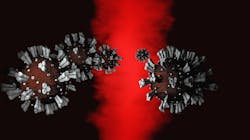Two studies say that coronavirus can persist on inanimate surfaces - they vary however, in how long they say the virus can live on metal, glass or plastic.
A study in the Journal of Hospital Infection said it can live up to 9 days. The second study was published in the preprint database medRxiv said the virus can remain viable in the air for up to three hours, on copper for up to four hours, on cardboard up to 24 hours and on plastic and stainless steel up to two to three days.
Both studies agreed that the virus can be efficiently inactivated by surface disinfection procedures with 62–71% ethanol, 0.5% hydrogen peroxide or 0.1% sodium hypochlorite within one minute.
In the medRxiv study, researchers analyzed the aerosol and surface stability of COVID-19 and compared it with SARS-CoV-1, the most closely related human coronavirus. They evaluated the stability of COVID-19 and SARS-CoV-1 in aerosols and on different surfaces and estimated their decay rates using a Bayesian regression model. This study has not been peer reviewed.
The results indicate that the greater transmissibility observed for COVID-19 is unlikely to be due to greater environmental viability of this virus compared to SARS-CoV-1. Instead, there are a number of potential factors which could account for the epidemiological differences between the two viruses.
There have been early indications that individuals infected with COVID-19 may shed and transmit the virus while pre-symptomatic or asymptomatic. This reduces the efficacy of quarantine and contact tracing as control measures relative to SARS-CoV-1. Other factors likely to play a role include the infectious dose required to establish an infection, the stability of virus in mucus, and environmental factors such as temperature and relative humidity.
In ongoing experiments, they are studying virus viability in different matrices, such as nasal secretion, sputum and fecal matter, and while varying environmental conditions, such as temperature and relative humidity.
The epidemiology of SARS-CoV-1 was dominated by nosocomial transmission and SARS-CoV was detected on variety of surfaces and objects in healthcare settings. COVID-19 transmission is also occurring in hospital settings, with over 3000 reported cases of hospital-acquired infections.
These cases highlight the vulnerability of healthcare settings for introduction and spread of Covid-19. However, in contrast to SARS-CoV-1, most secondary transmission has been reported outside healthcare settings and widespread transmission in the community is being seen in several settings, such as households, workplace and group gatherings.
A notable feature of SARS-CoV-1 was super-spreading events, in which a single infected individual was responsible for a large number of secondary cases, well above the average number denoted by the reproduction number Reff.
A tendency toward such super-spreading events has two important consequences for the epidemiology of emerging infections: it makes any given introduction of infection is the more likely to die out by chance, but when outbreaks do occur they are explosive and can overwhelm hospital and public health capacity. A number of hypothesized super-spreading events have been reported for COVID-19. Given that SARS-CoV-1 superspreading events were linked to aerosol and fomite transmission, our finding that Covid-19 has viability in the environment comparable to that of SARS CoV-1 lends credence to the hypothesis that it too may be associated with superspreading.
They found that the half-life of COVID-19 on cardboard is longer than the half-life of SARS-CoV-1. Taken together, the results indicate that aerosol and fomite transmission of Covid-19 are plausible, as the virus can remain viable in aerosols for multiple hours and on surfaces up to days.
The medRxiv research was supported by the Intramural Research Program of the National Institute of Allergy and Infectious Diseases (NIAID), National Institutes of Health (NIH). JOL-S and AG were supported by the Defense Advanced Research Projects Agency DARPA PREEMPT # D18AC00031, and JOL-S was supported by the U.S. National Science Foundation (DEB-1557022) and the Strategic Environmental Research and Development Program (SERDP, RC‐2635) of the U.S. Department of Defense.





